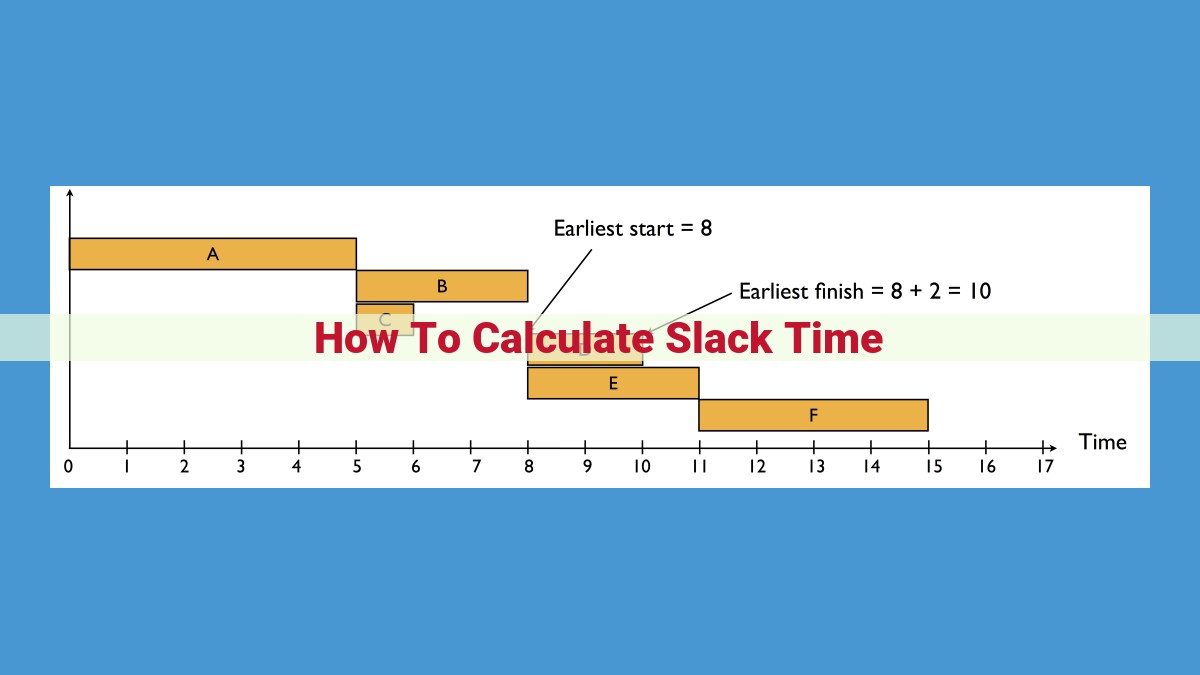Slack time, a buffer in project management, is calculated using concepts like float, critical path, and critical tasks. The forward pass finds early start/finish times and total float, while the backward pass finds late start/finish times. The comparison method directly calculates slack time as the difference between late and early finish times. Slack time helps identify bottlenecks, prioritize tasks, manage risk, and optimize schedules by adjusting durations and dependencies. Effective slack time management ensures project success and efficient resource allocation.
Slack Time: Understanding Its Significance in Project Management
In the realm of project management, slack time emerges as a crucial concept, representing the buffer period within a task’s schedule. It’s the cushion that allows projects to navigate unexpected delays and maintain progress. Slack time not only enhances flexibility but also plays a pivotal role in optimizing schedules and mitigating risks.
Understanding the Importance of Slack Time
In the dynamic world of projects, where uncertainties loom and unforeseen challenges arise, slack time serves as a lifeline. It provides project managers with the leeway to absorb unforeseen delays without jeopardizing project deadlines or compromising quality. By allowing for buffer time, teams can respond proactively to risks, allocate resources effectively, and maintain a steady project trajectory.
Effectively managing slack time empowers project managers to anticipate potential roadblocks, adjust task sequences, and optimize resource utilization. It’s a strategic asset that helps mitigate risks, maintain project momentum, and ultimately achieve project goals.
Concepts Related to Slack Time
Float
Float is the amount of time by which a task can be delayed without impacting the overall project timeline. There are two types of float:
- Total float is the total amount of time a task can be delayed without affecting the project’s completion date.
- Free float is the amount of time a task can be delayed without affecting any dependent tasks.
Float and slack time are interrelated. Slack time is the amount of time by which a task can be delayed without affecting the critical path, while float is the amount of time a task can be delayed without affecting the project completion date.
Critical Path
The critical path is the sequence of tasks that determines the project’s duration. Tasks on the critical path have zero slack time, meaning they cannot be delayed without delaying the project.
Critical Task
A critical task is a task that lies on the critical path. Critical tasks have a significant impact on slack time, as any delay in a critical task will directly impact the project’s overall timeline.
Non-Critical Task
A non-critical task is a task that does not lie on the critical path. Non-critical tasks have positive slack time, meaning they can be delayed without impacting the critical path. This flexibility in non-critical tasks provides opportunities for optimization, allowing project managers to adjust durations and dependencies to improve resource allocation and mitigate risks.
Calculating Slack Time: A Detailed Guide
Calculating slack time is essential for effective project management. It provides valuable insights into project progress and helps identify areas for optimization. Here are three methods for calculating slack time:
Forward Pass
The Forward Pass calculates early start and finish times, as well as total float. Here’s how it works:
- Early Start (ES): ES(i) = Max(ES(j) + Duration(j)) for all predecessors (j) of activity (i).
- Early Finish (EF): EF(i) = ES(i) + Duration(i).
- Total Float (TF): TF(i) = EF(i) – ES(i).
Backward Pass
The Backward Pass verifies total float and calculates late start and finish times. Here’s how it works:
- Late Finish (LF): LF(i) = Min(LF(j) – Duration(j)) for all successors (j) of activity (i).
- Late Start (LS): LS(i) = LF(i) – Duration(i).
- Total Float (TF): TF(i) = LF(i) – EF(i).
Comparison Method
The Comparison Method is a simplified approach for directly calculating slack time:
Slack Time = LS(i) – ES(i) = LF(i) – EF(i)
Understanding these methods empowers project managers to accurately calculate slack time and optimize project schedules for efficiency and success.
Leveraging Slack Time for Project Success
Slack time, often overlooked in project management, is a crucial resource that can significantly impact project outcomes. Understanding and effectively managing slack time can help you identify bottlenecks, prioritize tasks, manage risks, and optimize schedules.
1. Identifying Project Bottlenecks
Slack time analysis can pinpoint project bottlenecks—tasks with minimal or no slack time. By identifying these bottlenecks, you can focus resources and attention on them, ensuring that they do not delay the project’s progress.
2. Prioritizing Tasks for Efficient Resource Allocation
Prioritizing tasks based on their slack time allows for efficient resource allocation. Tasks with minimal slack time require immediate attention, while those with ample slack can be deferred to a later stage. This approach ensures that critical tasks are completed on time, while resources are not wasted on tasks that have room for delays.
3. Managing Project Risk and Uncertainty
Slack time provides a buffer against unexpected events and uncertainties. By strategically utilizing slack time, you can accommodate unforeseen delays and maintain project progress. This risk mitigation strategy ensures that projects are not derailed by unforeseen circumstances.
4. Optimizing Project Schedules
Slack time analysis enables you to identify tasks with excessive slack time. Adjusting the durations or dependencies of such tasks can optimize the project schedule. By reducing task durations, you can shorten the overall project timeline, while adjusting dependencies can improve resource allocation and reduce idle time.
